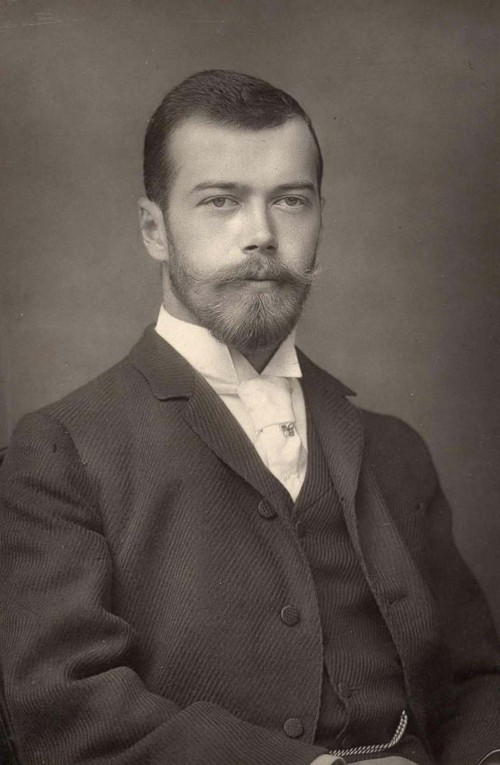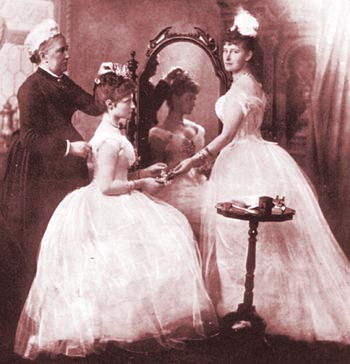
The Crowned Romanovs, Nicholas II and Alexandra Feodorovna, 1896 image
On May 26, 1896, the coronation of Tsar Nicholas II was held in Moscow. Four days later, the traditional public festival was to be held at a field five miles north of the city. At the invitation of the new tsar, every Russian was welcome. As Tsar Nicholas II was the absolute ruler of 1/6 of the earth and more than 120 million people, many people were expected. (3) All were promised free food, beer, gifts, and entertainment. The tsar himself was to appear at the central pavillion to watch the parade and greet his people.

The Khodynka Program of Events
Khodynka Field was the site selected for the popular celebration because it was the only place large enough to contain the expected crowd. However, Khodynka Field was not a natural fairground; it was a training ground for troops of the Moscow garrison. The field was crisscrossed by a network of shallow trenches used for moving troops and artillery and pitted with holes. Therefore, in preparation for the festival, wooden stalls, reviewing stands, and entertainment stages had to be built as well as bridges to span the enormous ditches. Barricades – really just skimpy wooden railings – protected the site from the crowds.

Khodynka Field is being prepared for the May 26, 1896, post coronation celebration for Russian Tsar Nicholas II.
Thrilled by the coronation and excited by the prospect of the carnival to be held at Khodynka Field, the people were “stirred up and restive.” (1) The night before, thousands thronged to the area and camped out in the open, waiting for dawn, when the turnstiles would open and they could enter the fairgrounds. As the group waited, a rumor began to spread
that there would not be enough gifts or food to go around. They had been promised sausage, bread rolls, sweets, nuts, gingerbread and a precious keepsake – a pink enamel mug bearing the arms of the city of Moscow and the words “In memory of the Holy Coronation,” all wrapped together in a colored kerchief stamped with the tsar and tsarina’s pictures.” (1)
More and more people came. There was much jostling and crowding. “The crush was so great a bullet could not have slipped through.” (2) Over the course of the night, made anxious by rumors of shortages, people pushed toward the barricades that guarded the entrance to the fairground in order to be the first in line when the gates opened.
It was sometime just before dawn when the barricades fell. The crowd surged forward, stampeding onto the meadow, rushing toward the food stalls. The patrol of 100 mounted Cossacks could not even begin to control the “mass of people half a million strong.” Khodynka Field, with its open trenches, became a deathtrap:
People by the thousands fell in a ditch and ended standing literally on their heads at the bottom. Others fell straight after them and more, and more….” (1)
Others, knocked down in the pandemonium, were trampled to death or mutilated by the incessant forward motion of the crowd. In minutes, Khodynka Field resembled a battlefield, strewn with carnage. People were fainting, gasping for air, vomiting, writhing, screaming, bleeding, lying dead or dying. Thousands were wounded, over 1300 were dead.

Trampled bodies cover Khodynka Field prior to the post-coronation celebration of Tsar Nicholas II of Russia, May 30, 1896.

Russians standing in the Khodynka Field in the aftermath of the riot that killed over 1300 Russians, May 30, 1896.
By 10:30 a.m., Tsar Nicholas II was told of the Khodynka catastrophe. He was shocked and sorrowful. Out of respect to the victims, his first inclination was to cancel the day’s activities which included not only his appearance at the Khodynka Field but a ball at the French embassy. But he gave into his advisors, his uncles, and kept to the official schedule. After all, France was Russia’s only European ally, he was reminded, and Russia could not afford to offend France. Besides, to adorn the ball, the French government had gone to great lengths, sending priceless tapestries and treasures of silver plate from Paris and Versaillles, along with 100,000 roses from the south of France. (3)
So the day went forward as planned. Bodies were carted off from the Khodynka Field where the tsar made his traditional appearance as if nothing had happened.

The celebration at Khodynka Field, parades and all, went on, despite the morning's carnage.
The French “ball was opened by the Majesties dancing a quadrille,” said the Minister of Finance.

The "Coronation Cup" given away at the Khodynka Field post-coronation celebration for Tsar Nicholas II. It has come to be known as the "Cup of Sorrows," commemorating the tragedy of 1300 people trampled to death that day in May of 1896.
Outward appearances aside, both the tsar and tsarina were deeply affected by the events at Khodynka. They visited the wounded in the hospitals. They paid for the burial of the dead. From the Tsar’s private purse, each victim’s family was remunerated. But no act of kindness could erase the terrible event from the Russian national consciousness. Many felt that the Khodynka Field Massacre was an omen that the reign of Tsar Nicholas II would not be a happy one. The tsar earned the nickname “Bloody Nicholas.”

Russian Empress Alexandra with her firstborn, daughter Olga, in 1896.
Secretly, throughout those long and difficult days, Empress Alexandra, the tsarina, had been expecting a child, her second after Olga. After the Khodynka tragedy, the Empress was greatly distressed and suffered a miscarriage. The lost baby was a boy, who, had he lived, would have become the male heir in line for the Russian throne, the boy everyone was clamoring for Alexandra to give birth to.

1897 photo of Russian Revolutionary Leon Trotsky, born Lew Dawidowich Bronstein
Shortly after Khodynka, Leon Trotsky began his Marxist political activity against Imperial Russia. Bread and circuses would not longer pacify the tsar’s people. The revolution had begun.
(1) Erickson, Carolly. Alexandra: The Last Tsarina. New York: St. Martin’s Press, 2001.
(2) Radzinsky, Edward. The Last Tsar: The Life and Death of Nicholas II. New York: Doubleday, 1992.
(3) Massie, Robert K. Nicholas and Alexandra. New York: Dell Publishing Co., 1967.
Readers: For more on the Russian Royal Family, click here.
Read Full Post »



















































